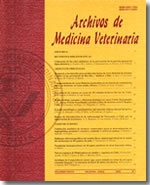Cuantificación de factores de riesgo para mastitis, quistes ováricos, hipocalcemia y cetosis usando regresión logística en ganado Holstein
Contenido principal del artículo
Resumen
Métodos intensivos de producción de leche se han asociado con un incremento de problemas de salud del rebaño. Un aumento en producción de leche, ya sea por genética o manejo, no siempre parece ir acompañado por un aumento de rentabilidad de la empresa lechera. Se ha indicado que vacas de mayor producción tienen mayores demandas en mano de obra y una mayor frecuencia de enfermedades. El objetivo de este trabajo fue cuantificar algunos de los factores de riesgo en la incidencia de mastitis, quistes ováricos, hipocalcemia y cetosis.
Casos clínicos, registrados como presentes o ausentes, fueron examinados usando regresión logística para cuantificar la asociación entre las enfermedades y las variables consideradas como factores de riesgo. Se estimaron las razones de riesgo y sus intervalos de confianza. Los datos fueron 8.391 observaciones en vacas Holstein canadienses. Los factores de riesgos considerados fueron: número de parto, estación de parto, año de parto, días en lactancia y producción de leche, grasa y proteína.
Número de parto fue un factor de riesgo en todas las enfermedades estudiadas. Estación de parto y producción de leche fueron significativamente importantes para quistes ováricos e hipocalcemia. Producción de grasa y proteína no estuvieron asociadas con ninguna de las enfermedades. Días de lactancia estuvieron asociados con quistes ováricos, pero no está claro si días en lactancia es una causa o un efecto de quistes ováricos.

